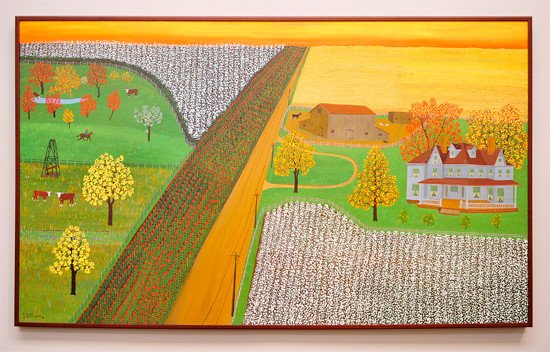
Rolling farms stretching to the horizon. Salt-of-the-earth farmers. Tractors sputtering to life at sunrise. These are the images one would expect to see in the Deere & Company art collection. However, the Figge Art Museum and the agricultural-machinery manufacturer have put together an exhibit that delves much deeper, into a diverse visual exploration of the natural, the mechanical, and the interplay between the two. Contrary to what one might expect given Deere's corporate identity, the show presents more than idealized visions of agrarian life; it frequently allows for artistic ambivalence about the industrialization of farming.
During the 1960s, Deere & Company began establishing an international art collection to complement its new modernly designed headquarters, and to represent its new global perspective. A majority of the collection represents work that was contemporary at the time it was purchased, but Deere also acquired art from earlier, including pieces by Grant Wood and Henri de Toulouse-Lautrec. The Figge's The John Deere Art Collection exhibit, which opened in November and runs through May 22, contains 36 works spanning from 1896 to the late 1970s and representing modern artists from around the world. This show is the first time that part of the collection has been on display outside of Deere headquarters.
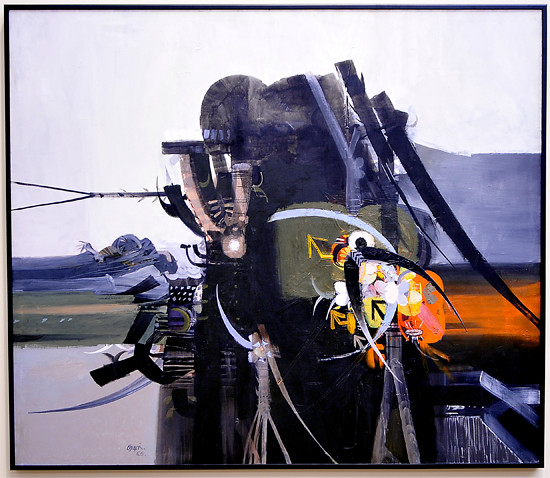
A prime example of the tension between the natural and mechanical themes of this exhibit is The Last Condor by Alejandro Obregon. This 1965 oil painting looks like a hulking cluster of machinery rising up from the bottom of the painting, implying that we are seeing only the top of a larger form. The mystery machine is mostly black, with sharp edges like wire or blades, giving it a threatening air. In contrast, in the center of the form is an explosion of brightly colored circles and feather-like shapes, an apparent expression of nature or hope. Obregon's application of bright colors resembles the lush tropics from his boyhood home of Columbia, yet the painting's foreboding tone aligns with its political unrest and fear. The title also references the country, as the condor is a traditional symbol of Columbia, yet its meaning could be interpreted as either hopeful or despairing. Does this black shape represent the destruction of the condor, or do the bright colors suggest the bird's power overwhelming the darkness? The visual combination of the mechanical and natural is ambiguous here, posing questions about the consequences of the relationship.
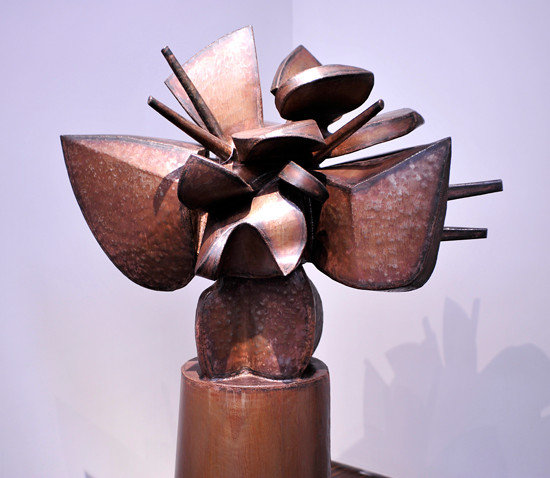
The exhibit includes three sculptures that also combine the biological and mechanized. Manuel Izquierda's metal sculpture Anvil Flower presents an industrial-looking plant. It's an abstracted, cubist-style flower form, with its petals and stamen radiating asymmetrically from its center. The result shows the natural beauty of the flower fused with the visual appeal of clean edges and metallic surfaces.
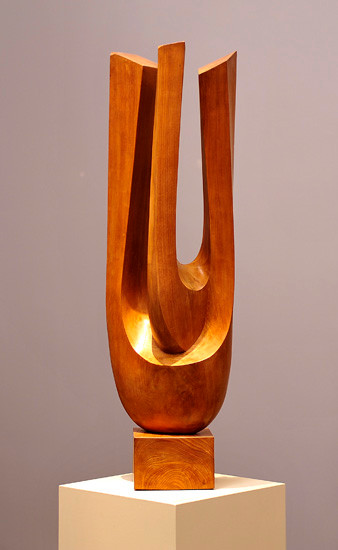
Takeo Kimura's Protean 4 emphasizes the mechanical through a nonrepresentational three-pronged form. The radiating arms of the sculpture are parallel and precise, yet briefly morph into a curving and sinuous line at the point where they branch off from the base, with each prong straightening out again on a slightly different plane from the others. The result mixes the implied functionality of a tool-like shape with a curvilinear flare, resembling a fork designed to look like the branches of a tree.
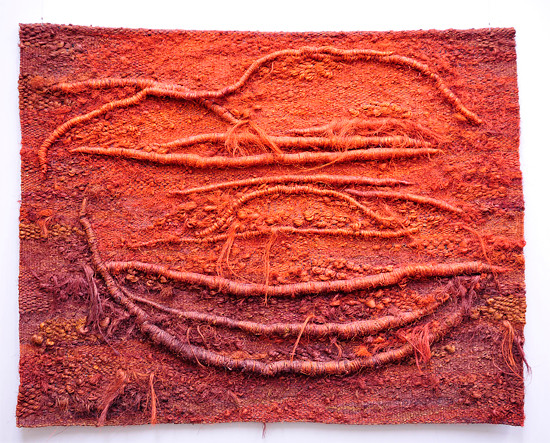
Magdalena Abakanowicz, in her work Relief Ore from 1975, uses a mechanical process to create an organic image. Relief Ore is a woven textile that includes wool, sisal, and flax used to create the visual effect of roots in soil. The basis of the work is a traditional warp-and-weft weaving, with some loops pulled out of the matrix to form small bulges. Across the entire surface, coils of varying thickness cross and overlap each other, like tree roots or vines. The reddish-brown color enhances the soil-like effect. This work employs the rigid, grid-based medium of weaving to create a flowing representation of an aspect of nature.
The John Deere Art Collection's agricultural landscapes less directly address the connection between machines and the land, but it's there by implication; contemporary farms could not exist without technology.
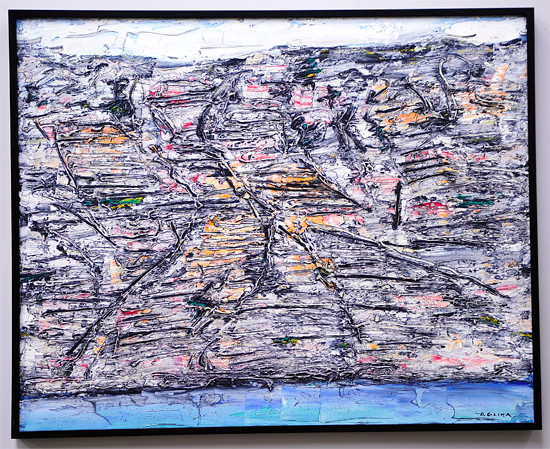
The 1968 oil painting Gromance #6, by Croatian artist Oton Gliha, shows an abstracted agricultural landscape. This work only suggests a landscape through lines, standing in for rows of crops, and a thin strip of white at the top, portraying a horizon. Gliha used thick impasto to render the soil, with coils of paint squeezed directly from the tube, and valleys carved into the thick surface. The paint shows chunky layers of unblended colors, mostly white with black, but with red, green, and yellow peeking out between the layers. The sky, in contrast, is thick paint that was smeared on with a palette knife, resembling icing on a cake. It's white, with hints of blue and gray, as though during winter, or seen through a smoggy haze. The bottom strip of the painting has the same texture, balancing the smooth sky, and is meant to suggest the stone walls surrounding farms in Croatia. (The title of the piece refers to these walls.) With its overwhelmingly gray color scheme and its rough, ragged textures, Gromance #6 feels isolated and bleak, yet intriguing through the hints of bright colors emerging from the haze. Like The Last Condor, Gromance seems to question agriculture's transformation of the earth.
Other landscapes show more of what one would expect from a Deere-themed exhibit - romanticized American agricultural scenes. The wall to the left of the entrance is dominated by four large folk-art-paintings from the 1960s by Streeter Blair. These works, each approximately six feet by four feet, present high-angle views of different agricultural landscapes. Texas, the largest of the four, demands attention, with its size and intense golden colors. Its style is skewed and simplified, with a child-like quality. We see one-point perspective in the crop lines converging toward the horizon, yet an entirely different perspective used in creating the buildings. Folk art such as Blair's often has these technically imperfect qualities. This creates an effect in which each section of the painting appears as an individual element, demanding closer consideration of the details of each part. The overall effect is whimsical, and hearkens back to the wholesome, simple, and peaceful aspects of rural America. Unlike Gliha's and Obregon's paintings, Blair seems to celebrate the farm as earth, man, and machine working together in harmony.
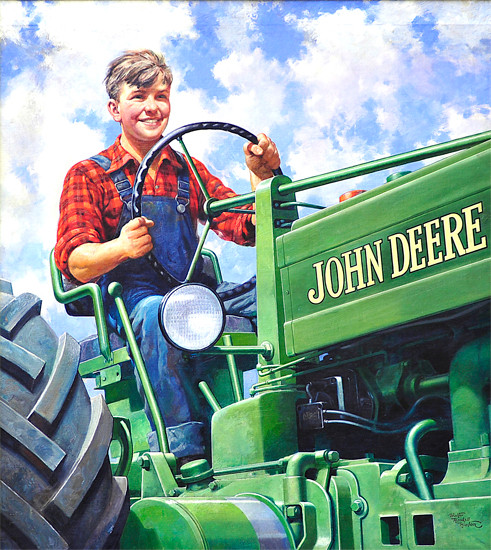
The three paintings by Walter Haskell Hinton also evoke warm nostalgia, especially the largest of the trio, Boy Driving Tractor from 1935. This oil painting, about two-and-a-half feet squared, features a young adolescent upon a tractor. The composition is from a low angle, as though looking up at the boy from ground level. Behind his head, there is nothing but blue sky with fluffy clouds. He has a slight smile, and appears completely confident controlling the machine. The mechanical details of the tractor, and its John Deere logo, are precisely included, an homage to the relationship between a farmer, his machines, and his land. All three Hinton paintings are saccharine but feel at home in the exhibit as a balance to some of the more clouded international work.
The John Deere Art Collection ends up as a mini-survey of Modernism across the world. Its scope and diversity - from idealized realism to mysterious abstraction - provide interesting fare for both art and agricultural enthusiasts, and the educational video and information sheet at the exhibit's entrance provide clear and illuminating background information. The idyllic farm images might seem out-of-place in proximity to large-scale abstract paintings and metallic sculptures, yet the underlying connection between the organic and the inorganic ties the work together. As farms are a perfect example of this conceptual hybrid, Deere & Company seems a logical patron for this body of work, and the exhibit demonstrates the resonance of the core theme across cultures and decades.
Michelle Garrison is a mixed-media artist who teaches art and design at Geneseo Middle School and J.D. Darnell High School. She can be reached at michelle_m_garrison@hotmail.com.










